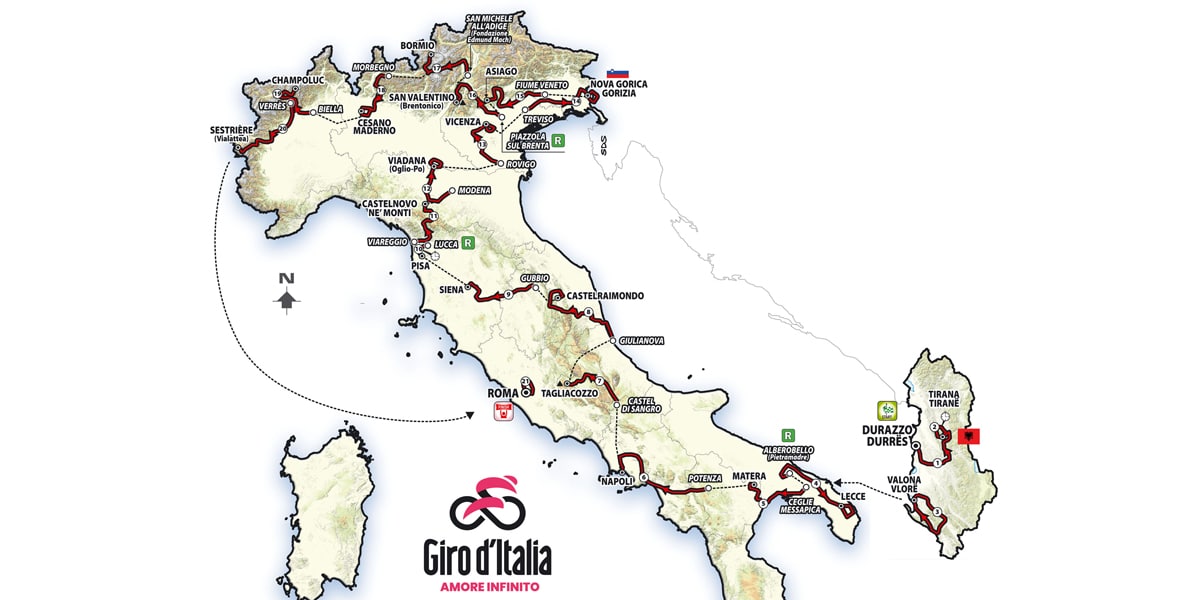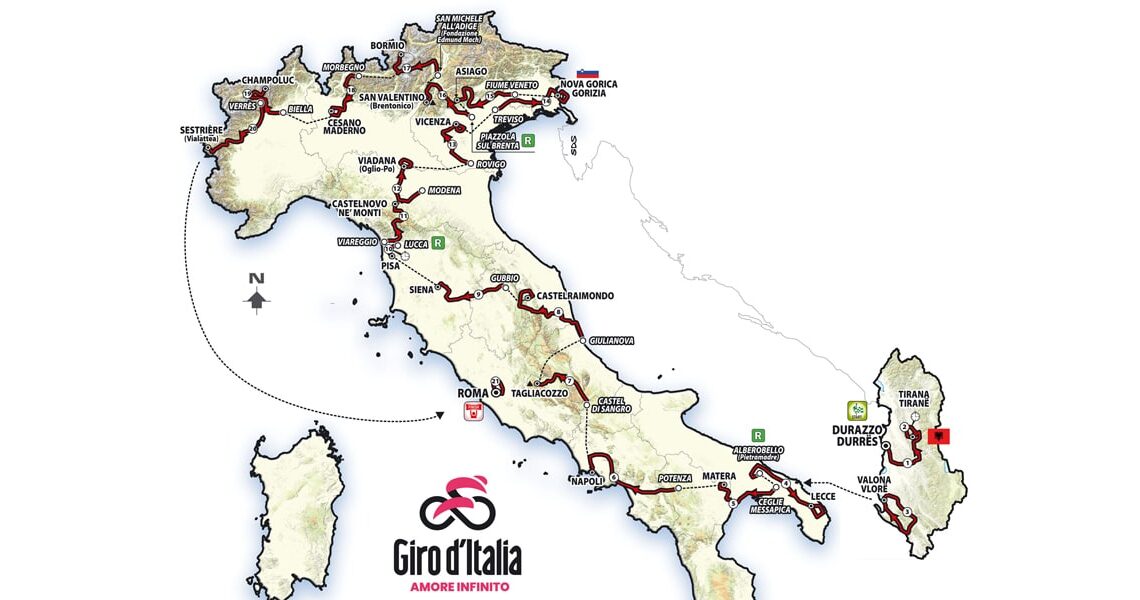
The Giro d’Italia will start abroad for the 15th time in its history—this time in Albania, where the first three stages will take place—and finish in Rome, which will host the Grande Arrivo for the 7th time. The race spans 3,413km with 52,500m of total elevation gain. Riders will face 2 individual time trials covering 42.3km, 6 sprinter stages, 8 medium mountain stages, and 5 high mountain stages from May 9 to June 1. Approximately 38 km of gravel roads will add to the challenge, including 30km of Strade Bianche in the finale of the Siena stage and 8 km on the Colle delle Finestre, which will be the Giro’s Cima Coppi at 2,178m. The Montagna Pantani will be the Passo del Mortirolo, while the Tappa Bartali will be the Gubbio-Siena stage, culminating in a spectacular finish at Piazza del Campo.
The routes of the 108th Giro d’Italia, scheduled from May 9 to June 1, and the Giro d’Italia Women, taking place from July 6 to 13, were presented at the Auditorium della Musica in Rome. Una Nessuna Centomila, a foundation dedicated to supporting women who are victims of violence and promoting gender equality, will be the Charity Partner of both events.
The presentation event was hosted by Pierluigi Pardo, Barbara Pedrotti, Ignazio Moser, and Eleonora Incardona, with audience interviews conducted by RTL 102.5’s Paolo Pacchioni.
Among the attendees were many prominent figures from the worlds of sports, entertainment, institutions, and companies that are and will continue to be part of the Giro d’Italia family.
On stage were Elisa Longo Borghini, winner of the 2024 Giro d’Italia Women, and three riders who have made history in the Corsa Rosa: Vincenzo Nibali, Alberto Contador, Paolo Bettini and Marta Bastianelli. Antonio Tiberi, winner of the last Giro d’Italia Maglia Bianca, also spoke during the presentation.
Institutional representatives were present as well, including the Deputy Prime Minister of Italy and Minister of Foreign Affairs, Antonio Tajani; the Minister of Agriculture, Food Sovereignty, and Forestry, Francesco Lollobrigida; Albanian Prime Minister Edi Rama; the President of ICE, Matteo Zoppas; the President of Enit, Francesca Priante; the President of Regione Abruzzo, Marco Marsilio; Silvia Salis, Vice President of CONI; Cordiano Dagnoni, President of Federciclismo; and Roberto Pella, President of the Lega del Ciclismo Professionistico.
The event was also attended by the Mayor of Rome Roberto Gualtieri, the Councillor for Major Events, Sports, Tourism, and Fashion of Rome, Alessandro Onorato, RCS MediaGroup President Urbano Cairo, RCS Sports & Events Managing Director and General Manager Paolo Bellino, Giro d’Italia Director Mauro Vegni, and La Gazzetta dello Sport Director Stefano Barigelli.

Grande Partenza: Albania
Three challenging stages, including an individual time trial through the streets of Tirana, set the tone for the 2025 Giro d’Italia in Albania. The opening stage ends in the capital with a challenging finale featuring two steep climbs with double-digit gradients, reminiscent of recent urban mountain stages. The time trial is followed by a stage finishing in Vlorë, featuring the ascent of Qafa e Llogarasë, the first climb above 1,000m in this year’s race.
First Week
After the first rest day on May 12, the race resumes with three stages that are likely suited to sprinters, but are not guaranteed to end in bunch finishes. The peloton climbs up the peninsula, culminating in the first summit finish in Abruzzo, in Tagliacozzo. After a stage finish in Castelraimondo, it will be time for the Gubbio-Siena stage, this edition’s Tappa Bartali, which features five sections of gravel roads (approximately 30km) before finishing in Siena’s iconic Piazza del Campo.
Second Week
The second rest day falls on May 19. The race resumes in Tuscany with a time trial from Lucca to Pisa, a modern homage to Knut Knudsen’s 1977 win. The following day, the Giro returns to the San Pellegrino in Alpe climb after 25 years, integrated into a tough stage with a finish in Castelnovo ne’ Monti.
Next come three tricky but crucial stages: a likely sprint finish in Viadana, a punchy finale in Vicenza atop Monte Berico, and a stage with a cross-border circuit in Nova Gorica/Gorizia. The week concludes with a tough stage to Asiago, featuring 3,900m of elevation gain but no uphill finish.
Third Week
After the final rest day, the peloton faces a massive mountain stage in Trentino: five grueling climbs packed into a single day, with an uphill finish at San Valentino (Brentonico) on Monte Baldo, overlooking Lake Garda.
The next stages include a dramatic finish in Bormio—featuring the Montagna Pantani, the Passo del Mortirolo—and a transition stage to Cesano Maderno.
The final two stages are designed for GC contenders. The first, from Biella to Champoluc, is short but features a staggering 4,950m of elevation gain, with uninterrupted climbing through the Aosta Valley. The second, from Verrès to Sestrière, revisits the legendary combination of the Colle delle Finestre (the 2025 Cima Coppi, featuring 8 km of gravel) and Sestrière, ensuring drama worthy of its 20th-anniversary appearance in the Giro.
The race concludes in Rome with a spectacular circuit through the Eternal City.

Numbers and Statistics:
3,413km in this edition
52,500m of elevation gain (10.000 more than in the previous edition)
15 starts from abroad for the Giro d’Italia
7 Grande Arrivo in Rome
38km of gravel in this edition
42.3km of individual time trials in this edition
5 times the Colle delle Finestre has been climbed (for the third time as Cima Coppi of the Giro).

# A PEZ Giro d’Italia 2025 ‘First Look’ comng soon. #
The post GIRO’25: A Challenging Route From the Very First Stages appeared first on PezCycling News.




